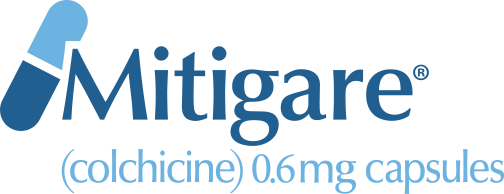
Whether you’re 30 or 80, you know that certain aspects of the aging process are inevitable. But it’s not a hopeless situation—there are things you can do to preserve your quality of life as you get older.1 Maintaining your mobility is one of them, and that’s why it’s so important to take good care of your joints.2,3 Effective gout management and certain lifestyle changes can help.4 Read on to uncover seven simple steps you can start taking now to protect your joints as you age with gout.
1. Manage your gout
One of the best things you can do to protect your joints as you age with gout is control the condition.5 Make appointments to visit your healthcare provider every six months for checkups and to have the uric acid level in your bloodstream measured.6 If your uric acid level is higher than 6.0 mg/dL, you may need a urate-lowering therapy (ULT) such as allopurinol to help reduce it.7 Your doctor may also prescribe a colchicine product such as Mitigare® (Colchicine) 0.6mg Capsules or Generic Colchicine 0.6mg Capsules to help prevent gout flares.7,8
2. Get active
The benefits of staying active as you age (with your doctor’s approval, of course) are many.1,3 Regular exercise can help ease arthritis pain, enable you to maintain a healthy weight, boost your mood and enhance your overall quality of life.1,3,9 Even short walks and simple stretches throughout the day can protect your joints and keep them healthy. Research shows that an exercise routine might also be a key to living longer.10 Data from a study of adults 40 years of age and older showed those who took 8,000 or more steps each day had a 51% lower risk of death (from any cause) than those who took only 4,000 steps each day.10
Always warm up and cool down
If you are new to exercise, be careful not to do too much too soon. Start slow and gradually increase the amount of time you spend working out. If you are more experienced and accustomed to more intense exercise, always begin and end every workout session with a warmup and cooldown (ask your healthcare provider or a certified personal trainer for guidance, if needed).3 A key goal of exercise is long-term mobility and health, so be patient with yourself, listen to your body and give it the respect it deserves.3,11
3. Drink more water
Did you know that about 80% of the cartilage in your body is made up of water?3 Unless you drink enough, your body will take it from your cartilage and other tissues, which can be hard on your joints.3 Want to drink more water each day? Consider keeping a reusable water bottle with you to sip from whenever you’re thirsty. If you consume sodas or energy drinks throughout the day, try swapping some or all of these with water. Eating foods with a high water content (think cucumbers, tomatoes, melons and lettuce) can also help boost your daily intake.
4. Maintain a healthy weight
You might already know that being overweight can increase the risk of gout and the painful flares that can accompany it.5 Additionally, carrying extra pounds is problematic because it can place additional stress on the knees, hips and other weight-bearing joints.4 Losing weight, however, has been shown to help reduce strain on the joints of people who are overweight or obese.4 For some, weight loss may even help to relieve joint pain, improve joint function and slow the development of osteoarthritis.4 Need help achieving or maintaining a healthy weight? Talk with your healthcare provider.
5. Eat well
Healthy eating is important at every age, but it becomes more critical as we approach midlife and beyond.12 Eating well can give you energy, help keep your weight stable and may even improve your mood.13-15 When choosing foods and drinks, consider how they contribute to your long-term wellness. Every healthy food decision you make has the potential to make a positive difference.
6. Consider adding calcium and vitamin D
Calcium and vitamin D are essential for maintaining bone, joint and muscle health.16 If you don’t get enough of them in your diet, supplements may help you reach your intake goals.16 The Endocrine Society and the Institute of Medicine suggest the following recommended daily allowances (RDA) for calcium and vitamin D for adults16:
- Calcium—Female adults age 51 and younger and male adults age 69 and younger should take in at least 1,000 mg of calcium each day. Females age 51 and older and males 70 and older should get 1,200 mg each day.
- Vitamin D—Adults age 69 and younger should take in 600 IU of vitamin D each day. Adults age 70 and over should take in 800 IU each day. Those who are vitamin D deficient or have low levels of vitamin D may need larger amounts of this vital nutrient.16
It is important to note that taking too much calcium or vitamin D can be harmful.16 Always talk to your doctor before you start any new vitamin or supplement regimen.
7. If you smoke, stop
Whether you have gout or not, it’s a good idea to avoid tobacco.1,3 Smoking can impact more than just your heart and lungs—it can affect bone and joint health as well.17,18 If you’re thinking about quitting, talk with your healthcare provider. He or she may be able to recommend a smoking cessation program or provide other support to help you quit for good.
Mitigare® is a registered trademark of Hikma Pharmaceuticals USA Inc.
Colchicine 0.6 mg capsules are contraindicated in patients with renal or hepatic impairment who are currently prescribed drugs that inhibit both P-gp and CYP3A4. Combining these dual inhibitors with colchicine in patients with renal or hepatic impairment has resulted in life-threatening or fatal colchicine toxicity. Patients with both renal and hepatic impairment should not be given Mitigare®.
Fatal overdoses have been reported with colchicine in adults and children. Keep Mitigare® out of the reach of children.
Blood dyscrasias such as myelosuppression, leukopenia, granulocytopenia, thrombocytopenia and aplastic anemia have been reported with colchicine used in therapeutic doses.
Monitor for toxicity and, if present, consider temporary interruption or discontinuation of colchicine.
Drug interaction with dual P-gp and CYP3A4 inhibitors: Co-administration of colchicine with dual P-gp and CYP3A4 inhibitors has resulted in life-threatening interactions and death.
Neuromuscular toxicity and rhabdomyolysis may occur with chronic treatment with colchicine in therapeutic doses, especially in combination with other drugs known to cause this effect. Patients with impaired renal function and elderly patients (including those with normal renal and hepatic function) are at increased risk. Consider temporary interruption or discontinuation of Mitigare®.
The most commonly reported adverse reactions with colchicine are gastrointestinal symptoms, including diarrhea, nausea, vomiting and abdominal pain.
Please see the full Prescribing Information and Medication Guide for Mitigare® for complete product details.
NOTE: This article was not written by a medical professional and is not intended to substitute for the guidance of a physician. These are not Hikma’s recommendations for gout flare prevention, but rather facts and data collected from various reliable medical sources. For a full list of resources and their attributing links, see below.
